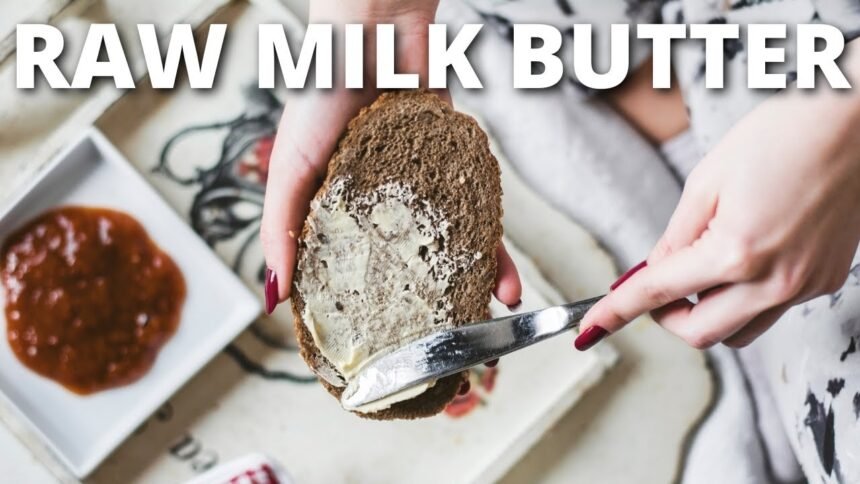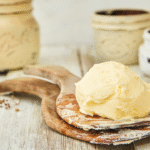Butter has been a staple in kitchens for centuries, cherished for its rich flavor and versatility. Long before supermarkets made butter easily accessible, families made their own directly from fresh raw milk. Many people today are rediscovering this timeless art, both for health benefits and the satisfaction of creating something wholesome at home. If you’ve ever wondered how to make butter from raw milk, you’re in the right place.
In this guide, you will learn the traditional methods, step-by-step instructions, tips for storage, and even where to buy raw butter if making it isn’t an option. By the end, you’ll not only know how to make raw milk butter but also understand why this process connects us to a simpler, more natural way of living.
Why Make Butter from Raw Milk?
Modern store-bought butter is usually made from pasteurized cream, which undergoes heating to kill bacteria. While this process improves shelf life, it also alters the enzymes and nutrients. Raw milk butter, on the other hand, retains its natural probiotics, enzymes, and a richer flavor.
Here are some reasons to try making it yourself:
-
Nutrient-rich: Raw milk butter contains vitamins A, D, E, and K in natural forms.
-
Probiotic benefits: Natural enzymes such as lactase help in digestion.
-
Superior taste: Homemade butter has a creamier, more authentic flavor compared to store-bought alternatives.
-
Sustainability: Reduces dependency on processed products and connects you with traditional methods of food preparation.
-
Economical: If you already have access to raw milk, making butter can be cost-effective.
What You Need to Get Started
Before learning how to make butter with raw milk, gather the right tools and ingredients.
Ingredients:
-
Fresh raw milk (from cows, goats, or sheep)
-
A pinch of salt (optional, for flavor)
Equipment:
-
Large glass jars or wide bowls for collecting cream
-
A ladle or spoon
-
A mixer, blender, or traditional churn
-
Cheesecloth or strainer
-
Cold water (for rinsing the butter)
-
Airtight container (for storage)
How to Separate Cream from Raw Milk
The first step in how do you make butter from raw milk is collecting the cream. Butter is made from the fat content in milk, so you need to separate the cream from the raw milk.
-
Allow the milk to rest: After milking, let the raw milk sit undisturbed in a cool location or refrigerator for 12–24 hours. The cream naturally rises to the top.
-
Skim the cream: Use a ladle or spoon to carefully scoop the thick layer of cream into a separate bowl or jar. Collect as much cream as possible without disturbing the milk underneath.
-
Save the skimmed milk: Don’t throw away the remaining milk—it can be used for drinking, baking, or making cheese and yogurt.
Step-by-Step: How to Make Raw Milk Butter
Now that you have your cream, let’s move on to the butter-making process.
Step 1: Churn the cream
-
Pour the cream into a butter churn, standing mixer, or blender.
-
Beat it at medium speed. After several minutes, the cream will thicken into whipped cream. Continue beating until it separates into butter solids and buttermilk.
Step 2: Separate butter and buttermilk
-
Once the butter clumps together, pour off the buttermilk. Save it—it can be used in pancakes, biscuits, or as a starter for fermentation.
Steps 3: Rinse the butter
-
Place the butter in a bowl and gently wash it with cold water. Knead or press it with a wooden spoon, rinsing repeatedly until the water runs clear. This ensures longer shelf life by removing leftover buttermilk.
Step’s 4: Add salt (optional)
-
For flavor, sprinkle in a pinch of natural salt. This helps preserve the butter while enhancing taste.
Steps 5: Store your butter
-
Pack the butter into a glass jar, ceramic dish, or wrap in parchment paper. Keep it refrigerated for freshness. Properly rinsed butter can last up to 2 weeks in the fridge or several months in the freezer.
Tips for Perfect Raw Milk Butter
-
Temperature matters: Cream churns best at around 55–60°F (13–15°C). If it’s too cold, it won’t separate easily; too warm and it may turn greasy.
-
Amount needed: It takes about 2 quarts (half gallon) of cream to make 1 pound of butter.
-
Flavor variations: Experiment with adding herbs, garlic, or honey for unique homemade butters.
-
Cultural traditions: In many cultures, butter is fermented slightly before churning, which gives a tangy flavor and boosts probiotics.
Common Questions
1. How long does it take to make raw butter?
The whole process (excluding cream separation) usually takes 15–20 minutes.
2. Can you make butter without a churn?
Yes. A blender, mixer, or even shaking cream in a jar can work just as well.
3. Is raw milk butter safe?
If your raw milk comes from trusted farms that maintain hygiene and grass-fed cattle, it is generally safe. Always ensure high cleanliness during preparation.
Health Benefits of Raw Milk Butter
Raw butter is not just delicious—it’s nourishing:
-
Rich in CLA (Conjugated Linoleic Acid): Supports metabolism and immune health.
-
Omega-3 fatty acids: Beneficial for brain and heart health.
-
Butyrate: A fatty acid found in raw butter that supports gut health and reduces inflammation.
-
Fat-soluble vitamins: Improves calcium absorption, bone health, and helps balance hormones.
Where to Buy Raw Butter
If making butter at home isn’t practical, you may ask: where to buy raw butter? The answer depends on your area, since raw milk and its products are regulated differently around the world.
-
Local farms: The best option is farmer’s markets or direct relationships with small dairy farmers.
-
Co-ops and buying clubs: Many natural food co-ops offer raw dairy access through networks.
-
Online suppliers: Some websites specialize in farm-to-door delivery of raw dairy, though availability depends on local laws.
For reliable advice on sourcing high-quality raw dairy, the Weston A. Price Foundation provides resources and a directory of trusted farms.
Read More: How to Make Butter from Raw Milk at Home: A Step-by-Step Guide
The Joy of Old-Fashioned Butter Making
Learning how to make butter from raw milk is more than just a recipe—it’s a connection to tradition, sustainability, and health. Each step gives you a chance to slow down, appreciate natural food sources, and enjoy the satisfaction of making something with your own hands.
For some, it’s about taste; for others, it’s a return to simplicity and self-sufficiency. Either way, whether you’re spreading fresh butter over homemade bread or stirring it into vegetables, you’ll notice the difference immediately.
Butter made from raw milk stands as a reminder that some of the oldest ways of doing things are still the best.







